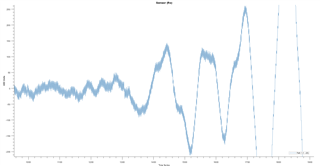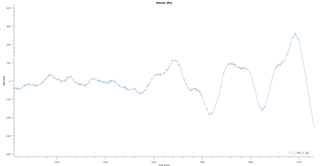Hello,
I am using the Texas Instruments AFE5803 in a high-speed ultrasonic data-acquisition system. When initially studying the datasheet, I saw the AVERAGING_ENABLE option, which allows averaging the inputs on two channels together automatically in order to increase SNR. I had this feature designed into the PCB, such that our input signal coming from piezoelectric sensors is split and routed into two separate input channels on the AFE5803. (Specifically, I have it routed into channels 5 and 6. As per pg 26 of the datasheet, that would mean the signal comes out on channel 5.)
In the firmware, I've written code to configure the AFE5803 registers accordingly. Things are mostly working, except that I'm seeing an extremely high amount of jaggedness/spikiness in the measured sinusoidal signal. See the following plot, which is zoomed-in on a small portion of the signal to show details:
In the plot above, the Y axis is ADC units; the X axis is sample number. So one unit of the X axis corresponds to one unit of time in the ADC's sampling frequency (24 MS/s, in this case). The "spikes" are discrete time points. This is not an artifact of how the data is plotted or visualized. There is no post-processing being done in software; this is simply plotting the "raw" data sampled by the ADC.
This was expected to be a smooth, sinusoidal signal. Yet, here, it has such high-frequency noise mixed into it that it almost looks "fuzzy".
I originally attributed the problem to a flaw in the circuit design. However, upon the advice of a colleague, I dug further into this "spiky" noise. An FFT revealed that the predominant frequency in a particularly "spiky" subsection of the signal was roughly 12 MHz, which is half of the 24 MHz sampling frequency. This is roughly two orders of magnitude greater than the frequency of the signal being measured (which is in the hundreds-of-kHz range). Furthermore, the distinct periodicity of the "spike" pattern suggested that it was a digital artifact, rather than an analog one.
I was surprised to see that when I turned off averaging for the AFE5803 (by setting bit 11 of register 2 to be 0), this "spikiness" in the signal pretty much went away:

Certainly, there is still some noise in the signal, but that is much lower-frequency noise (kHz-range, not MHz-range), presumably coming from switching power supplies or other components.
Has anyone ever seen anything like this before when using the built-in channel averaging of the AFE5803 or related TI AFEs? This is very odd behavior, and I am at a loss for an explanation. All of the register configuration and code seems correct. This looks to me like a bug in the implementation of the digital averaging on the IC. I would appreciate any ideas or suggestions on what could be causing this!

